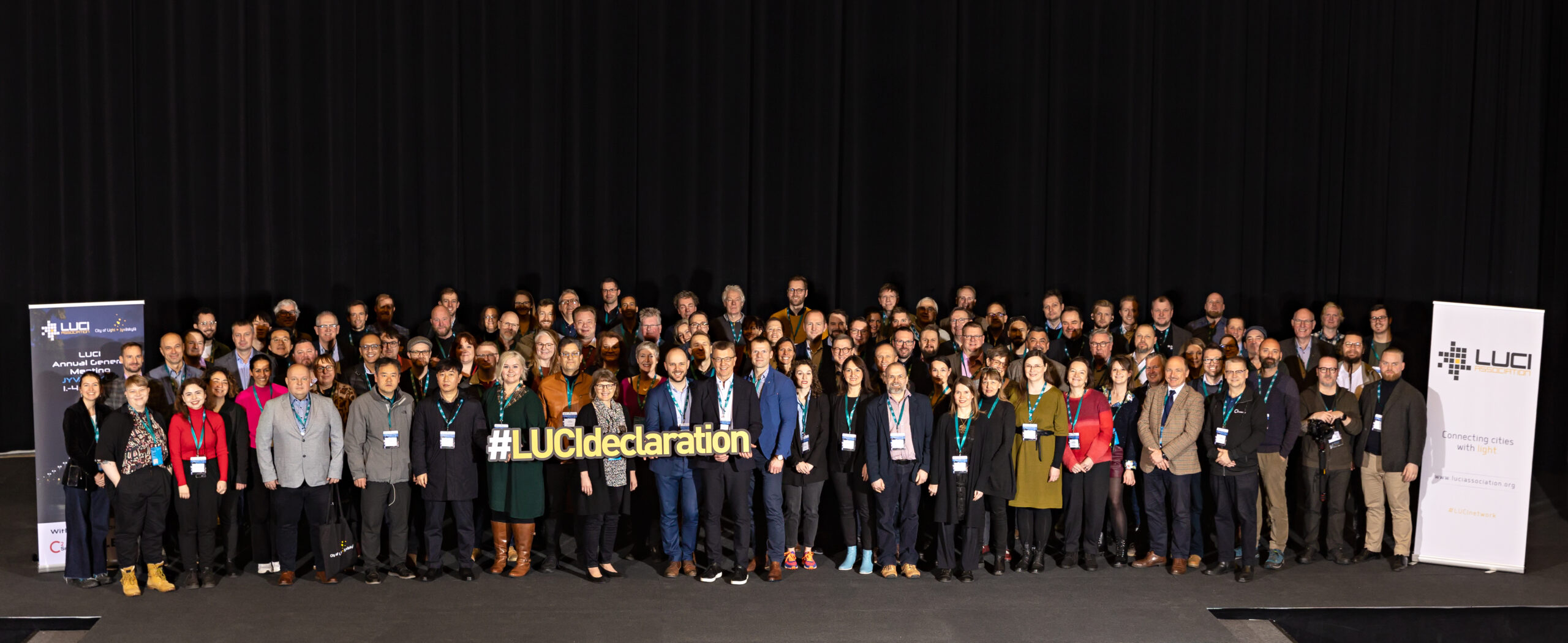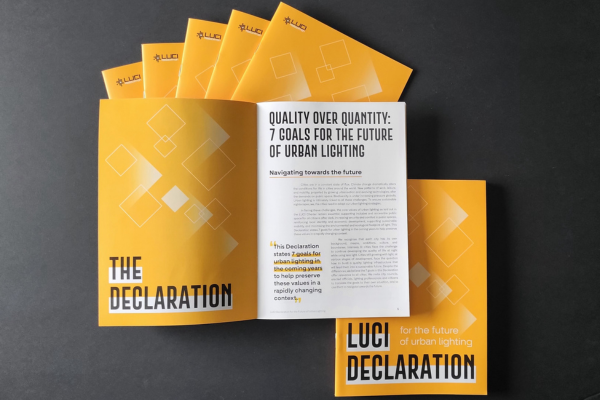By: Mark Burton Page, LUCI Association
Lighting strongly impacts important aspects of our lives: mobility, the feeling of safety, leisure and culture, social cohesion and diversity of our cities, amongst others! The recognition of light’s importance has led to the rise of urban lighting strategies, projects and events focused around light worldwide in the past 30+ years. But in the context of the climate mutation and energy crises, increased awareness of light pollution and the impacts of light on biodiversity and human health, we need to consider light as a precious public good, to be used with care in the right place, at the right time and at the right level.
The challenge is to promote an inclusive public space, accessible to all after dark, to improve the safety and comfort of public spaces, to strengthen local identity and economic development, while minimizing the environmental and ecological footprint of light.
With this in mind, cities worldwide have adopted in March 2023 the LUCI “Declaration for the Future of Urban Lighting”, giving seven main objectives to our collective journey.

- Embracing Net Zero Lighting
Lighting can help cities achieve the United Nations’ Net Zero GHG emissions targets by 2050, provided they commit to reducing emissions during the process of producing, operating and maintaining street lighting. While replacing traditional sources with more energy-efficient LEDs is an undeniable step forward, it is not enough. Cities will need to adopt energy-efficient strategies: master plans for sustainable lighting, prevention of excessive outdoor lighting, smart lighting[1] strategies for dimming and the use of solar lighting. When socially acceptable, the removal of light at certain times and in certain areas should be considered. Similarly, the criteria for choosing lighting equipment will have to consider its entire life cycle.
- Minimising light pollution
A growing global problem, light pollution impacts all sensitive species, whether humans or wildlife. For cities, current lighting policies need to be re-examined and tailor-made with lighting scenarios that meet the needs of inhabitants with as little light as possible. Viable strategies that can mitigate the environmental impact of lighting include reducing the number of sources, reducing the length of on-time, reducing intensity especially with eg. adaptive dimming technologies, narrowing the spectrum, particularly by limiting the use of bluish light produced by white and “cold” LEDs.
- Supporting health and well-being
Urban lighting strategies are designed to balance safety and security requirements with the need to promote the health and well-being of city dwellers. In the Declaration, cities invite readers to pay attention to research on the impact of lighting on our mental health and on sleep-wake cycles, to ensure that urban lighting has as few negative effects on our health as possible. In addition, it must aim to strengthen the links between people and the places that they share, helping to create safe, comfortable and attractive environments that in turn promote the health and well-being of inhabitants. This also means developing closer collaborations between lighting designers and urban planners and treating night and day equally throughout the urban planning process.
- Progressing through public-private dialogue
- While private lighting often makes a positive contribution to the nighttime urban landscape, it can also be an additional source of disruption for example through over-illuminated advertisements. Faced with this, preventive measures such as the establishment of clear guidelines for public design or regulations limiting the level of lighting can be effective.
- Collaborating more with private sector actors can help improve urban lighting. Indeed, a better dialogue and sharing of insights between the cities and the market parties can bring about better hardware, software and services that fits the needs of cities. Cities are in the driver’s seat and can become more explicit about their requirements in public tenders.
- Realising the full potential of community engagement
People make cities and citizen participation is a real lever for the acceptance and completion of public lighting projects: it offers the possibility to the inhabitants to take ownership of the projects and makes it possible to integrate upstream the diversity of their needs and expectations. There is no one-size fits all approach to urban lighting and urban lighting can be a great tool for placemaking.
- Harnessing the transformative power of light art
Whether it is the enhancement of heritage through light or the temporary or permanent installation of artworks in public space, light is a strong vector of creativity and identity for cities. It also offers opportunities to bring citizens together, both literally and figuratively. It is interesting to continue exploring these modes of artistic expression, for example during light festivals, which give the opportunity to test new urban concepts and experiment with new dimensions of urban space.
- Creating synergies beyond lighting
Urban lighting plays multiple key roles in the city, intertwined with other urban policies: smart cities, nighttime policies, etc. As such, for cities, these should be linked much more closely and be more subject to synergies, including in terms of financing. Similarly, disciplines that contribute to sustainable urban lighting, such as social sciences, information and communication technologies, urban planning and ecology, have a strong interest in collaborating more closely with light professionals.
The 7 goals of the Declaration are deepened in 4 thematic chapters on some of the key points addressed:
- How to meet the challenges of minimising light pollution;
- How to develop urban lighting policies for happy and healthy cities after dark;
- How to move towards a community-driven approach of urban lighting;
- How to envisage the future of light festivals.
Current environmental, social and economic developments ask for a strong and unprecedented response from urban lighting. This Declaration argues giving precedence to quality over quantity. Urban lighting is a long term infrastructure and we need to act now, the Declaration is intended to guide cities in the coming 3, 5, 10 years to navigate the complex policy landscape and inspire to sustainably realize the strong potential of urban lighting for a sustainable quality of life.
The Declaration is being translated in 5 languages (French, Spanish, Korean, Dutch, Finish) and will be available in more languages worldwide.
> You can Download the full text of the Declaration).
> We welcome feedback and your perspectives to enrich the next phases of worldwide cooperation on urban lighting (luci@luciassociation.org).
About the LUCI Network
LUCI (Lighting Urban Community International) is the international network of cities on urban lighting. Created in 2002 and based in Lyon, France, today LUCI is a non-profit organisation bringing together close to 70 member cities worldwide. It also includes over 50 associated members from the lighting industry, design agencies and research institutes.
About the LUCI Declaration
The Declaration, adopted by LUCI city members in March in Jyväskylä (Finland), proposes recommendations for adapting urban lighting strategies to climate change, changing lifestyles and technological evolutions, with a focus on quality over quantity. “This document is the result of a year-long process in the LUCI Network, that we did during our 20th anniversary year in 2023. Many working groups and events, attended by hundreds of lighting professionals and city representatives, allowed for the document to be truly co-created” said Meri Lumela, Deputy Chair of the City Council of Jyväskylä and current President of LUCI.
[1] For global approaches on Smart Lighting, please see A cities Guide to Smart Lighting, A white paper from cities for cities about the why and how behind Smart Lighting, 46p LUCI 2022 and “Smart Lighting paving the way to a sustainable future” in Cities & Lighting Magazine n°9, LUCI 2021














